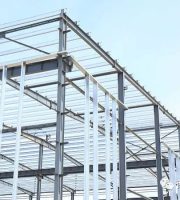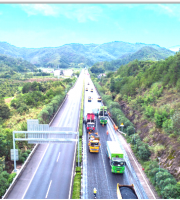Construction process flow chart of percussion drill bored pile I construction preparation · site leveling (1) three supplies and one leveling shall be completed before excavation.
(3) Before operation, the crane shall be inspected and tested safely and reliably to ensure construction safety.
The pile position measurement is divided into preliminary measurement and retest, which are before and after the pile casing is excavated and buried.
The on-site control points shall be poured with concrete, and protective signs shall be installed to prevent displacement due to collision during construction.
III.
Mud shall be made by drilling clay.
3.
4.
The top of the positioning pile shall be 20cm higher than the top of the pile casing, and shall be buried in the ground not less than 30cm.
When the reinforcement enters the site, the variety, specification, model, batch, heat number, production quantity and supply quantity of each heat number shall be checked, and the test pieces shall be taken for mechanical property test according to the regulations, and the quality must meet the provisions of relevant standards.
Source: copyright of Luban union of construction engineering belongs to the original author.
Acceptance of fixed interface and final hole.
When affected by the fluctuation of groundwater level, it shall be more than 1.5m higher than the groundwater level or not lower than the natural ground· Percussion drill percussion drill can adapt to various geological conditions, especially drilling in pebble layer.
Obstacles such as aboveground and underground cable pipelines and equipment foundation have been removed.
During hole forming, water shall be added in time to adjust the mud specific gravity: ≤ 1.25; Viscosity: 18-20s; Sand content: ≤ 6%.
If the requirements are met, it can be transferred to the next process.
Its operation method is: after the positive circulation is rushed into the final hole, bind the mud pipe to the steel wire rope of the hammer head, slowly put it into the hole bottom, carry out the normal circulation and hole cleaning of mud, and pump in new mud with large pump capacity that meets the performance index requirements; Sand content of returned mud ≤ 6%; Mud specific gravity ≤ 1.25; Thickness of sediment at hole bottom ≤ 50mm.
After the hole depth is measured for the first time and reaches the corresponding drilling depth, the first hole cleaning is completed· Mud viscometer, Mud Hydrometer and sediment meter are specially used to detect the sediment at the bottom of the hole.
(2) Be familiar with construction drawings and underground soil and hydrogeological data of the site.
For the variable layer and the parts prone to deflection, the method of low hammer tapping and intermittent impact shall be adopted to pass through, so as to keep the hole shape good· Interface rock sample · final hole rock sample VI first hole cleaning · first hole cleaning the first hole cleaning is also very important.
The construction can be in place only after it is accepted by Party A and the supervising engineer.
Buried depth of pile casing: it shall not be less than 1.5m in cohesive soil; Not less than 2.0m in sandy soil; The top of pile casing is 30cm higher than the ground.
3.
5.
Check the business license, production license, factory certificate and manufacturer’s test report of the reinforcement manufacturer.
The thickness of the sediment at the bottom of the hole can be accurately measured by using a special microelectrode probe tube and circuit design· Mud index detection and final hole acceptance pile hole final hole.
2.
2.
Four positioning piles are set at the more stable parts outside the pile casing, and the positioning piles are made of φ 20 reinforcement shall be buried at the position 1 ~ 2m away from the pile casing.
During drilling, the mud surface in the hole shall be more than 1m higher than the groundwater level.
2) Fabrication of reinforcement cage 1.
The hole depth shall not be less than the design hole depth; 4.
5.
According to the technical code for building pile foundation (JGJ94-94) and design requirements, the following quality standards shall be implemented: 1.
Role of pile casing: protect the orifice, locate and guide, isolate the surface water, maintain the height of water head in the hole, prevent collapse, fix the reinforcement cage, etc· In order to correct the center of the pile casing and pile hole, the “+” cross method is adopted before excavating the pile casing.
The allowable deviation of pile position center shall not be greater than 50mm; 2.
IV.
The casing shall be buried accurately and stably, the deviation between the casing center and the pile position center shall not be greater than 20mm, and the inclination of the casing shall not be greater than 1%.
The stiffening stirrups of reinforcement cage shall be set at a spacing of 2m, and the main reinforcement and stiffening stirrups shall be connected by spot welding..
For frame structures with seismic requirements, the strength of longitudinal stressed reinforcement shall meet the design requirements; For the seismic grade I and II, the measured strength value obtained from the inspection shall comply with the following provisions: ① the ratio of the measured tensile strength to the measured yield strength of the reinforcement shall not be less than 1.25; ② The ratio of the measured value of yield strength of reinforcement to the standard value of strength shall not be greater than 1.3.
Then, the axis, pile position setting out and elevation control are carried out according to the point.
The hole diameter shall not be less than the design pile diameter; 3.
Apparent quality of reinforcement: the reinforcement shall be straight and free of damage, and the surface shall be free of crack, oil stain, granular or flake old rust.
Percussion drill has stronger adaptability than other types of drill.
Before hammer opening, enough clay and water must be added into the pile casing, and then add clay to make slurry while impact, so as to ensure the feasibility of clay slurry wall protection.
4.
Punching hammers (as shown in the figure) have various shapes, but most of their punching edges are cross shaped· Structural drawing of 3pnl-12 pump · five impact hole forming of mud pump· Impact hole forming 1.
4.
(4) The site shall be leveled according to the elevation required by the design drawings, all obstacles above and underground at the pile position (including large stones, tree roots and garbage) shall be removed, and the low-lying parts of the site shall be backfilled and compacted· Measurement and positioning of mud pit II · measurement and positioning: firstly, according to the building positioning coordinate points and elevation points measured by the planning department, use the total station to measure the on-site control network in the site area, which will be used as the basis for on-site construction setting out after being verified by the representative of Party A and the supervisor.
In case of brittle fracture, poor welding performance or significantly abnormal mechanical properties of reinforcement, chemical composition inspection or other special inspection shall be conducted for this batch of reinforcement.
All temporary facilities such as temporary electricity, temporary water and safety facilities are ready.
buried casing · buried casing 1.
After the retest is qualified, it can be driven Ф 12 one positioning steel bar shall be used as the positioning mark of the drilling machine, and then the elevation of the pile casing and floor shall be measured with a level gauge.
The section length of reinforcement cage shall be cut according to the requirements of blanking sheet.
In the process of drilling, according to the geotechnical investigation report, when entering the moderately weathered tuff, the technician of the construction unit shall check the rock sample, report it to the supervisor and Party A for final hole inspection after the self inspection meets the requirements.
After passing the self inspection, the construction unit, together with Party A and the on-site supervisor, shall inspect and accept the hole diameter, hole depth, pile hole verticality, hole bottom sediment and other indicators according to the technical specifications and design requirements.
After the labels are filled in, bag them and keep them.
At the same time, the hole is formed with an impact drill, and a dense soil layer is formed around the hole wall, which plays a certain role in stabilizing the hole wall and improving the bearing capacity of the pile foundation.
The percussion drill shall be aligned with the center of the pile casing with a deviation of ≤± 20mm, start low hammer close blow with a hammer height of 0.4 ~ 0.6m, and add clay slurry to protect the wall in time to compact the hole wall until the hole depth reaches 3 ~ 4m below the pile casing, then speed up, increase the stroke, raise the hammer to more than 1.5 ~ 2.0m, and turn to normal continuous impact.
The pile casing is generally made of 4 ~ 8mm steel plate, its inner diameter shall be 200mm larger than the design pile diameter, and 1 ~ 2 slurry overflow holes are set at the upper part.
The verticality deviation of pile hole shall be less than 1%· Measuring hole diameter · measuring hole depth VII reinforcement engineering 1) reinforcement raw materials 1.
In case of deviation, stop drilling immediately and take measures to correct it.
During drilling, the perpendicularity of the hole shall be checked every 1 ~ 2m.
20cm thick circular concrete with a radius of 20cm shall be poured for fixation, marked with red paint, and the positioning pile shall be protected during construction.
The drilling rig must be flat and stable on the sleeper to ensure no displacement or inclination during construction; The error between the drill bit center and the casing Center shall not be greater than 20mm.
drilling rig in place · drilling rig in place.
2.
During acceptance, take out samples from the retrieved drilling slag, find out the rock samples and fill in labels such as rock stratum depth and sampling time.
3.



